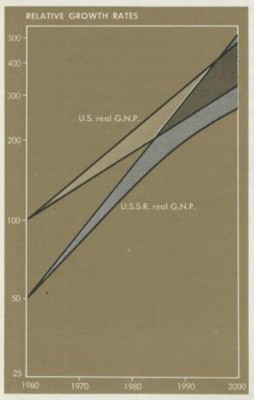
When the Soviet Union catches up the United States in terms of GNP? Graph from Paul Samuelson’s Economics, 1961 edition (via Marginal Revolution).
Long time ago, a joke used to be popular: In 1950s, the Eastern bloc had a goal to outpace America, in 1960s it aimed to catch up with the U.S. and in 1970s it wanted to do its best to not lose the U.S. out of the sight. Funny thing is that even professors of economics in the United States themselves were often not able to see the worse performance and lagging of centrally planned economies. Too much of intellectual work sometimes makes people forget to look out of the window.
An exemplary case is represented by Paul Samuelson. One of the most recognized economists of the 20th century, the Nobel Prize laureate and the author of the most popular textbook of economic principles ever written. In the 1967 edition of this book, a possibility of Soviet Union’s GNP catching up with the U.S. GNP sometimes between 1977 and 1995 appears (read this article on why GNP is not necessarily a good indicator of economic performance). Every following edition shifted the prognosis somewhat further into the future. Finally, in 1985, it was erased from the textbook. Professor Samuelson received the Nobel Prize in 1989, the very year when the economies of the communist countries collapsed in Europe.
This interesting thing, and many, many others can be found in the new book Zlé peniaze (Bad money) published by INESS recently.



